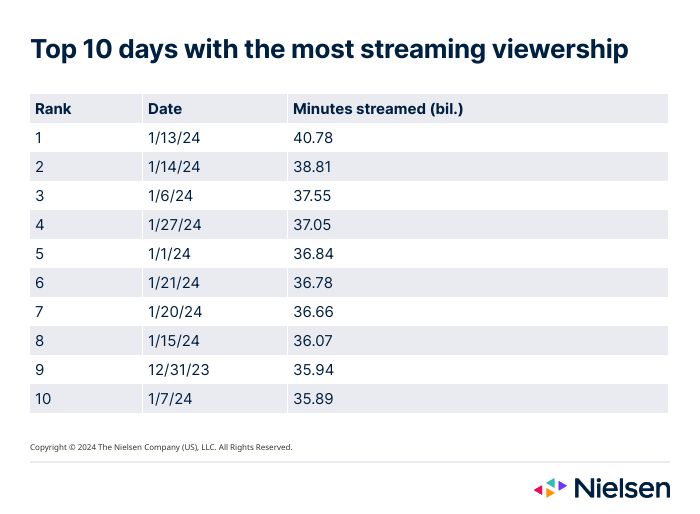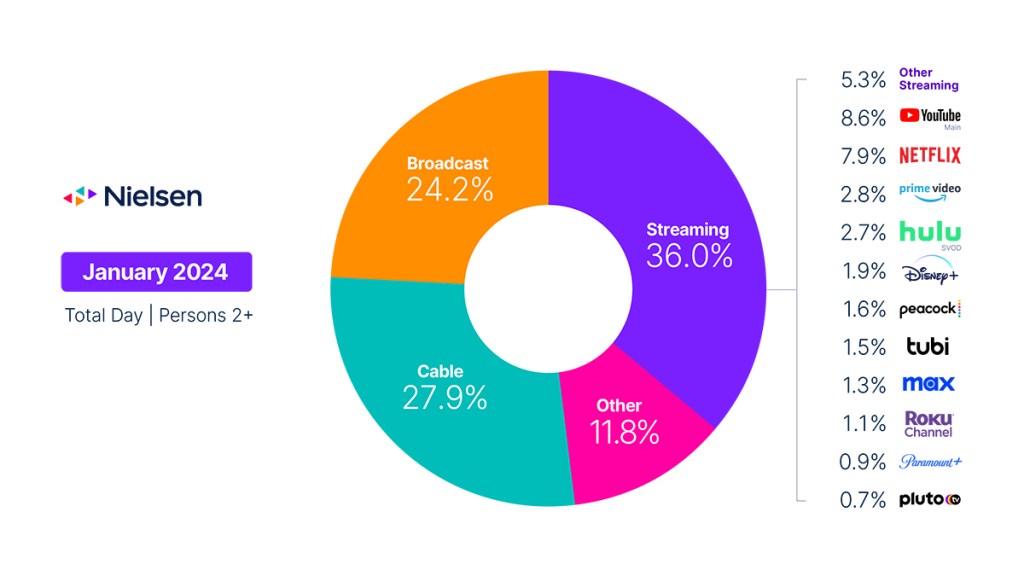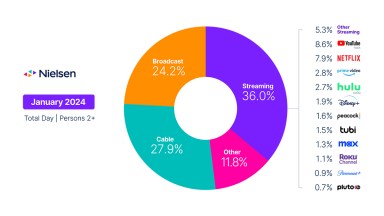Audiences stream a record 40.8 billion viewing minutes on Jan. 13, 2024
Chilly weather, coupled with the excitement of the NFL playoffs, helped boost total TV viewership 3.7% in January. While historically characteristic for the month, the uptick was perhaps more noteworthy because it was 1.4% above its level last year—a reporting period that was longer and wasn’t in short supply of new programming. In fact, January 2024 included three of the top 10 days with the most TV viewing since Nielsen began producing The Gauge in May 2021.
While football is always a heavy driver of TV viewing, colder-than-usual weather played a role in TV viewing in markets that aren’t as seasonally cool, including Tulsa and Portland, where TV viewing increased 10% and 7%, respectively. And in Tampa, the cooler temps and the Buccaneers’ playoff run combined to bolster TV viewing by 14% on a year-over-year basis.
The power of the NFL playoffs also rippled into the streaming landscape, as the Wildcard game between the Miami Dolphins and Kansas City Chiefs on Peacock generated almost 3.9 billion viewing minutes (including local viewing in Kansas City and Miami), and helped Jan. 13, 2024 take the crown for having the largest daily volume of streaming on record. In total, January 2024 included nine of the top 10 days with the highest streaming volumes ever recorded by Nielsen, with New Year’s Eve 2023 (which was recorded in the December interval) sneaking in at No. 9.

In addition to colder weather, January welcomed the beginnings of new, scheduled drama programming, which accounted for a 20% increase in viewing on broadcast networks. NBC’s Chicago franchise (Chicago Fire, Chicago Med, Chicago P.D.) led the way, representing some of the first “new” scripted content of the broadcast TV season. Combined with a 36% rise in sports viewing, broadcast was able to grow its share of TV by 0.7 share points to end the month at 24.2% of TV. With the arrival of new programming still somewhat limited, however, broadcast viewing was down 20% compared with a year ago.
Cable viewing was up 2.7% in January, but the rise in total TV usage resulted in a 0.3 share point loss to land at 27.9% of TV. Seasonality played a role here, as viewers transitioned away from holiday-themed movies, which led to a decrease of more than 19% in feature film viewership. Comparatively, news viewing picked up, accounting for 19% of overall cable usage, with the Iowa Town Hall on Fox News Channel becoming the only non-sports program to land in the top 10 cable broadcasts (excluding sports commentary). And while sports programming was less prevalent on cable, football games dominated the most-watched programs, including the College Football Playoff game between Michigan and Alabama on New Year’s Day, which took the top spot with 26.1 million viewers.
Like broadcast, streaming also benefited from the return of new scripted programming, with Fool Me Once on Netflix topping the list of most-watched programs with 6.5 billion minutes—the first time an original has topped the streaming charts since Queen Charlotte – A Bridgerton Story did so in May 2023. Bluey, on Disney+, and Reacher, on Amazon Prime Video, were close behind, with 5.5 billion minutes and 4.3 billion minutes, respectively. In total, streaming usage was up 4.1% in January.
At the platform level, YouTube marked its 12th consecutive month as the top streaming service. Peacock saw a 29% spike in usage, driven by NFL playoff coverage, to account for a record 1.6% share of TV. Netflix gained 0.2 share points to end the month at 7.9% of TV, its highest since August 2023, and the 10% increase in Roku Channel usage bumped its share back to 1.1% of total TV.
February, in addition to including viewership for the Super Bowl, will mark the formal start of an abbreviated broadcast TV season, which could offset some of the viewing declines that typically follow the end of the NFL season. With spring not yet on the horizon, the continued arrival of new content across traditional and streaming channels will likely keep audiences engaged until warmer weather arrives.

January data trends with Brian Fuhrer
本ゲージは、放送、ストリーミング、ケーブルなど、主要なテレビ配信プラットフォームにおける視聴者の視聴行動を毎月マクロ分析したもの。また、主要な個別ストリーミング配信事業者の内訳も含まれている。チャートそのものは、月次のテレビ総視聴率を、カテゴリー別および個々のストリーミング配信事業者別の視聴シェアに分けたものである。
メソドロジーとよくある質問
The Gaugeはどのように作られるのですか?
The Gaugeのデータは、2つのパネルから別々に加重平均されたものであり、それを組み合わせてグラフを作成している。ニールセンのストリーミングデータは、全米TVパネル内のストリーミングメーター対応TV世帯のサブセットから得たもの。リニアTVソース(放送とケーブル)と総使用量は、ニールセンのTVパネル全体の視聴に基づいている。
データはすべて、各視聴ソースの期間に基づく。放送月を表すデータは、報告間隔のLive+7視聴に基づいている(注:Live+7には、テレビのライブ視聴に加え、リニアコンテンツの7日後までの視聴が含まれる)。
その他」には何が含まれるのか?
ザ・ゲージの「その他」には、放送、ケーブル、ストリーミングのカテゴリーに分類されないすべてのテレビ利用が含まれる。これには主に、その他のチューニング(未測定ソース)、未測定のビデオ・オン・デマンド(VOD)、オーディオストリーミング、ゲーム、その他のデバイス(DVD再生)の利用が含まれる。
2023年5月のインターバルから、ニールセンはストリーミング・コンテンツ視聴率を利用し、同サービスで報告されているプラットフォームが配信するオリジナルコンテンツを特定し、ケーブルのセットトップボックス経由で視聴されたコンテンツを再分類し始めた。この視聴は、ストリーミングとそれを配信したストリーミング・プラットフォームにクレジットされる。また、これまで反映されていたその他のカテゴリーからも削除される。ストリーミング・コンテンツ・レーティングの中でオリジナルと特定されていないコンテンツで、ケーブルセットトップボックスを通じて視聴されたものは、引き続きその他に含まれる。
その他のストリーミング」には何が含まれますか?
その他のストリーミング」として記載されているストリーミングプラットフォームには、個別に区分されていないテレビでの広帯域ビデオストリーミングが含まれる。ライブ放送やケーブル(リニア)番組を配信するために設計されたアプリ(Sling TVやCharter/SpectrumのようなvMVPDまたはMVPDアプリ)は、"その他のストリーミング "から除外される。
リニアストリーミングはどこに貢献するのか?
リニアストリーミング(vMVPD/MVPDアプリへの視聴の集計によって定義される)は、これらのアプリを通じて視聴される放送およびケーブルコンテンツがそれぞれのカテゴリにクレジットされるため、ストリーミングカテゴリから除外される。 この方法論的な変更は、2023年2月のインターバルから実施された。
ニールセンについて HuluやYouTubeでのライブストリーミングとは?
vMVPDアプリ経由のリニアストリーミング(例:Hulu Live、YouTube TV)はストリーミングカテゴリーから除外されている。ストリーミングカテゴリーの「Hulu SVOD」と「YouTube Main」は、リニアストリーミングを含まないプラットフォームの利用状況を指す。



